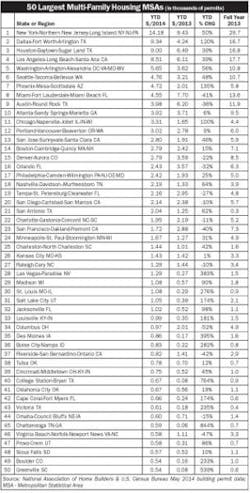Although construction economists typically focus on single-family housing starts as one of the most important indicators to consider when monitoring the health of the building market, multi-family housing projects with five units or more have been center stage recently because this market segment recovered faster from the recession than single-family home construction.
According to the U.S. Census Dept.’s most recent value of new construction data, spending on multi-family construction through May is up 30.7% YOY in 2014 to $40.5 billion, while spending on single-family housing is up 10.9% YOY over the same time period to $187.9 billion.
Multi-family housing will probably struggle to maintain the torrid pace of its 2011-2013 recovery from the recession, but growth looks solid again this year. The National Association of Home Builders (NAHB), Washington, D.C., is calling for a 14.1% gain in multi-family starts in 2014, down from +55.7% in 2011, +38.9% in 2012, and +25.1% in 2013. NAHB forecasters do expect the multi-family market to cool down in 2015 and 2016, with national increases of 3.6% and 0.86%, respectively.
In an NAHB press release on the latest data for its Multifamily Production Index (MPI), which is now showing nine consecutive quarters of growth in the multi-family housing market, W. Dean Henry, CEO of Legacy Partners Residential in Foster City, Calif., and chairman of NAHB’s Multifamily Leadership Board, said, “Developer confidence in market-rate and low-rent units has been pretty stable for quite some time. Now we’re really starting to see confidence in the condo market start to catch up — a segment that had been delayed in its recovery — along with the single-family market.”
It’s interesting to note that while NAHB expects the multi-family market to outpace the single-family market’s 2014 growth of 10.7%, in 2015 and 2016 its forecasts call for the single-family market to really take off and outpace the multi-family market with 37.8% growth in 2015 and 21.9% growth in 2016, compared to the multi-family market’s growth of 3.6% and 0.86% over the same time periods.
While it’s important to consider national housing data, the real and perhaps more interesting story in the multi-family segment is what’s happening in the local housing markets. Each local market has its own story to tell on the demographic and economic trends that shape its demand for multi-family housing. In some markets, publicly-owned global real estate investment trusts (REITs) like AvalonBay Communities, which owns 276 apartment communities with 82,374 units and has 31 new communities under construction, build and own thousands of multi-family rental units, while in others local or regional builders are the key players. Markets also differ in the demographics of the buyers moving into new apartments, condos and other multi-family units.
In what Multifamily Executive, a housing business publication, calls the “sexy six” markets of the multi-family business — New York, Los Angeles, San Francisco, Boston, Washington, D.C., and Seattle – there’s a mix of young professionals who want to live closer to their jobs in urban centers and retirees who don’t want to do the upkeep of their suburban homes anymore and want to live in a city with nearby cultural amenities, shopping, etc. There’s also plenty of multi-family housing being built along the beltways linking the suburbs to the urban core.
In a Nov. 2013 post at www.multifamilyexecutive.com, the website of HanleyWood’s Multifamily Executive magazine, Alex Goldfarb, managing director of equity research of REITs for New York-based Sandler O’Neill + Partners, said Dallas, Houston and Charlotte, N.C. may become the newer, sexier metropolitan areas of the future. “I think the Sunbelt will emerge as a very healthy strong area,” he said in the post.

